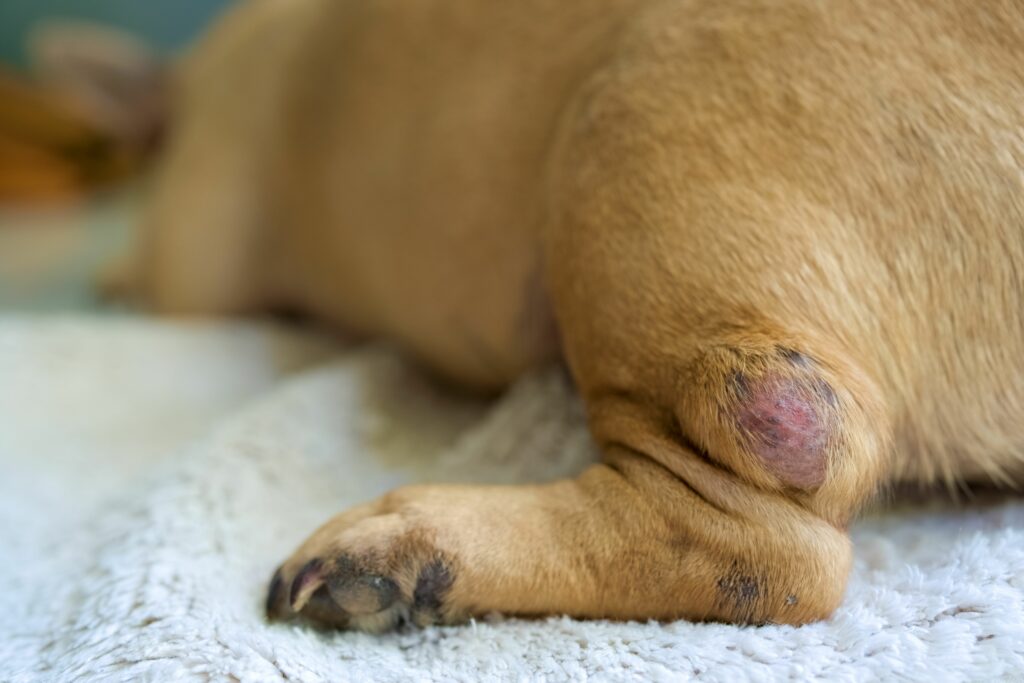Fleas, those tiny beings that make pets feral cats and humans alike itch, are more than just a nuisance. These small creatures are called “wingless bloodsuckers” and belong to the order Siphonaptera.
They are the most common external parasites found on our furry friends, dogs, and cats. Despite their petite size, fleas can cause big problems if left unchecked.
Flea Allergy Dermatitis in Pets: Understanding the Itch
Dive into the world of flea allergy dermatitis in pets, a common but often misunderstood condition. Uncover the root causes and symptoms of this allergic reaction to flea bites. Learn how to identify if your pet is suffering from flea allergy dermatitis and the importance of prompt intervention for their comfort.
Symptoms and Treatment of Flea Allergies: A Comprehensive Guide
Explore a comprehensive guide to the symptoms and treatment of flea allergies in pets. From incessant scratching to skin inflammation, understand the signs indicating a flea allergy. Delve into effective treatment options, ranging from topical solutions to oral medications, ensuring your pet finds relief from the discomfort of flea allergies.
Managing Flea Allergies in Pets: Proactive Strategies for Relief
Discover proactive strategies for managing flea allergies in pets. Explore not only treatment options but also preventive measures to keep your furry friend free from flea-related discomfort. This guide empowers you to take control, implementing a holistic approach to manage and alleviate flea allergies in your beloved pet.
Flea Allergy Prevention Tips: Safeguarding Your Pet’s Well-being
Prevention is key to safeguarding your pet’s well-being. Unearth a trove of flea allergy prevention tips to keep your pet itch-free. From regular grooming practices to maintaining a flea-free environment, these tips provide a proactive defense against the onset of flea allergies in your cherished companions.
The Itchy Culprits: Allergies Caused by Flea Bites

Fleas may not be harmful on their own, but their bites can cause allergic reactions in pets and people. When a flea bites, it injects saliva into the skin. The saliva contains irritating compounds like histamine.
In some individuals, these allergenic components cause itching, redness, and discomfort. Pets with flea bite allergies called ‘flea allergy dermatitis’ (FAD), can have a strong allergic reaction from a single flea bite.
FAD is a common skin issue seen in vet dermatology clinics, linked in skin diseases to external parasites. Allergic reactions can manifest in various ways.
Pets with FAD may itch intensely, causing excessive scratching and chewing. This can lead to hair loss and raw skin. This can make them susceptible to secondary bacterial skin infections.
Not only domestic dogs but also dog owners and cat lovers may deal with itchy welts from flea bites. Humans are less prone to severe flea issues than pets, but some can be highly sensitive to flea saliva.
we’ll discuss fleas and allergies, including their life cycle, diagnosis, treatment, and prevention. So, fasten your seatbelts and get ready to embark on a journey to conquer these tiny foes!
Understanding Fleas
Anatomy and Life Cycle of Fleas
Fleas, the small blood-sucking pests bothering our pets, have a fascinating anatomy and life cycle. They belong to the Siphonaptera order, with bodies adapted for survival on a host.
Their flat shape aids quick movement through fur or feathers, and strong hind legs enable impressive jumps. These pests have sharp mouthparts for feeding on blood. These mouthparts make them well-suited for their parasitic lifestyle.
The life cycle of fleas can be divided into four stages: egg, larvae, pupae, and adult. Female fleas lay eggs on the host (usually a pet) which then fall off onto the surroundings such as carpets, upholstery, or pet bedding.
Tiny eggs hatch into larvae, feeding on organic debris like flea dirt. After molting and growth stages, they spin cocoons, enter the pupal stage, and later emerge as adult fleas.
How Fleas Infest Pets and Homes
Now that we know how fleas go from eggs to adults in our homes, let’s understand how they infest our pets and living spaces. Pets can become hosts when exposed to infested environments or other animals, like in parks. Fleas can quickly leap onto unsuspecting pets during outdoor adventures or inside homes.
Once on a pet’s warm body, fleas feed on blood and lay eggs, perpetuating a cycle of flea infestation throughout. Flea bites can also cause allergic reactions in some pets.
Pets that are sensitive to flea bites may itch a lot because their immune system reacts to flea population and strongly to flea saliva. This can cause flea allergy dermatitis (FAD), causing itchiness and bacterial or yeast infections.
Understanding fleas’ anatomy and life cycle helps us grasp how these parasites enter our homes and get on our pets. When we know this, we can now manage flea numbers, shield pets from flea infestations, and lower the risk of allergy-related problems.
Allergies Caused by Flea Bites

Flea allergies aren’t triggered by the bite itself but by the saliva injected during feeding. Flea saliva contains proteins that, in some individuals, can cause an overactive immune response in both humans and pets.
The immune system sees flea saliva proteins as invaders and releases histamines and other chemicals to fight them. This leads to inflammation, itching, and discomfort in the affected area.
The severity of the allergic reaction varies from person to person or pet to pet. Some may feel a bit itchy, while others could have more serious issues like blisters or infections from scratching too much.
Common Symptoms Experienced by Allergic Individuals
Flea bite allergies show up differently based on sensitivity and immune response. Both humans and pets may experience itching at the bite site. Many look toward scratching or biting to alleviate discomfort.
Allergic individuals may also have redness or raised bumps called papules or wheals around the bite area. Pets can suffer from hair loss and open sores on their skin due to continuous scratching and self-inflicted trauma.
These open sores can become infected if left untreated. Pets with lots of fleas can get a skin condition called Flea Allergy Dermatitis (FAD), also known as flea bite hypersensitivity.
This happens when a cat’s immune system reacts strongly to fleabites, causing an intense allergic response. Symptoms of FAD can include intense itching, redness, crusting, and oozing sores.
Prompt treatment is essential to alleviate the suffering of pets experiencing these symptoms. People with existing skin conditions like atopic dermatitis may react more strongly to flea bites affected cat, or dog scratches.
If you think you or your pet might be allergic to flea saliva, consult a healthcare professional or vet for a diagnosis and treatment. Use flea products regularly and keep your environment clean to prevent allergic reactions from fleas.
Flea Allergy Dermatitis (FAD): Detailed explanation of FAD as a common skin condition in pets

Flea Allergy Dermatitis (FAD) is a skin condition that affects many pets. It occurs when animals develop an allergic response to the saliva of fleas.
The allergy dermatitis in dogs and cats arises from the body’s immune system overreacting to flea saliva. This reaction triggers intense itching, redness, and discomfort for our furry friends.
When fleas bite an allergic animal, their saliva causes an exaggerated immune response. When fleas bite, proteins in their saliva can trigger an immune response. This response causes the release of histamine and causing inflammation.
This influx of histamine causes intense itching and irritation at the site of the bite. Histamine, released by the immune system, can spread throughout the body.
Discussion on the severity and chronic nature of FAD
Flea Allergy Dermatitis can be a severe condition for pets affected by it. A cat with flea allergy dermatitis (FAD) can experience intense itching for days or weeks from flea saliva. Continuous scratching may cause hair loss, open sores, scabs, and bacterial infections.
One challenging aspect of FAD is its chronic nature. If a dog or cat gets flea allergy dermatitis from flea saliva, their sensitivity can last a lifetime without proper care.
Pet owners need to stay watchful in controlling fleas on their pets and in their homes. It’s crucial to manage fleas, especially for those dealing with FAD, as even occasional exposure can lead to a severe reaction.
To prevent fleas and manage FAD, use regular topical flea preventives or oral medications to kill fleas. Also, practice environmental management to eliminate flea eggs and larvae. In severe cases, vets may suggest antibiotics for bacterial infections or allergy shots to desensitize pets to flea saliva proteins.
Flea Allergy Dermatitis can make life tough for dogs and cats. Understanding its causes and taking caution can help pets suffering from flea allergies.
Diagnosing Flea Allergies

Explanation of diagnostic methods used by veterinarians for pets with flea allergies
Vets use different methods to diagnose flea allergies in pets. One common approach is a thorough physical examination where the vet checks your pet’s skin and fur for signs of fleas or related issues.
The exam helps identify symptoms like redness, itching, hair loss, and flea dirt (tiny black specks from digested blood). The vet may also use a Flea Comb Test, catching adult fleas or eggs with a fine-toothed comb.
The test visually confirms and assesses the infestation severity. If the physical exam is inconclusive or other secondary skin infections or conditions are present, vets may suggest advanced diagnostic methods.
Skin testing introduces small amounts of allergens, like flea saliva, into your pet’s skin. Reactions at specific sites indicate sensitivity to those allergens.
Blood tests can measure antibodies, giving detailed info on your pet’s immune response to flea bites.
Overview of allergy testing options for humans with flea bite allergies
Humans, like our pets, can be allergic to flea bites. If you think you’re allergic, it’s important to get medical advice for the right diagnosis and treatment. Allergy testing options available for humans include both skin testing and blood tests.
Skin testing generally involves two methods: prick tests and intradermal allergy tests. In prick tests, small amounts of allergens, including flea saliva in this case, are gently pricked into the skin using a tiny needle.
The doctor looks for reactions such as redness or swelling, which could be an allergy. Intradermal allergy tests inject small amounts of allergens below the skin’s surface. They then check for similar reactions.
Specialized blood tests, such as the IgE antibody test, can also aid in diagnosing flea bite allergies in humans. These tests measure levels of specific antibodies called immunoglobulin E (IgE) produced in response to flea bites.
High IgE levels confirm an allergic reaction to fleas, aiding in the diagnosis. Accurate testing is crucial for a comfortable life and effective treatment.
Treatment Options for Flea Allergies
Arsenal Against the Itchy Invaders: Treating Flea Allergies in Pets
If your pet has flea allergies, there are effective treatments to ease their symptoms. Use spot-on products directly on the dog’s skin for a convenient way to kill fleas and prevent future infestations.
Use treatments with insecticides or growth regulators to target fleas at various life stages. Oral medications, prescribed by your vet, are also a popular option.
Medications circulate in your pet’s body. These help in killing fleas when they bite and preventing reproduction. Flea collars with repellents provide long-lasting protection.
Evicting Fleas from Your Home: Environmental Management Measures
To fight fleas at home, vacuum carpets, rugs, furniture, and crevices regularly. It removes adult fleas and their eggs and larvae.
Wash bedding and linens in hot water to eliminate fleas. Use indoor insecticides to target and stop adult fleas or their growth stages.
For a bad or severe flea infestation problem or if home treatments don’t work, get professional pest control. They use special methods to remove all fleas from your home.
Maintaining a Safe Haven: The Importance of Regular Grooming and Cleanliness

To avoid future flea allergies, groom your pets regularly and keep their coats clean and well-maintained.
Give your pets frequent baths using a mild shampoo made for them to wash away fleas and their saliva. Cleanliness in the home is equally essential.
Wash pet bedding, vacuum carpets, and eliminate flea-hiding spots regularly. This will help to reduce the risk of more serious flea infestations. Maintain good hygiene for pets and living space to create an environment fleas don’t like.
To treat flea allergy dermatitis, address immediate symptoms, and prevent future or most flea infestations. Combine effective pet treatments with proper home environmental management for long-term relief.
Preventing Flea Allergies

Regular use of preventative products like spot-on treatments or oral medications
Keep your pets flea-free and prevent allergies by using regular spot-on or oral flea prevention and control treatments. These products contain active ingredients that repel and kill fleas, ensuring your pet stays protected.
Apply spot-on treatments between the shoulder blades, and give oral medications by mouth. Ask your vet to help choose the best option for your pet.
Frequent grooming practices such as bathing, brushing, and combing
Regular grooming helps prevent flea issues in your pets. Regular bathing helps remove any existing fleas on your pet’s fur and calms their itchy skin.
Keep your pets’ skin healthy by using a mild shampoo made for them, which also removes fleas and their eggs. Regular brushing and combing are crucial to spot early signs of fleas, like black flea dirt or live fleas.
Pay special attention to areas where fleas tend to hide. These may include, behind the ears, near the tail base, and under armpits. Remember to dispose of any collected hair or debris in a sealed bag.
Maintaining a clean living environment through diligent housekeeping
Prevent flea allergies in your pets by keeping a clean home. Vacuum often, especially on carpets, upholstery, and floor cracks where eggs may hide. Dispose of the vacuum bag right away to stop flea eggs from hatching and coming back.
Washing your pet’s bedding in hot water weekly can also eliminate any eggs or fleas. If your pet lays on furniture, consider using washable covers that can be cleaned.
Use flea spray or insecticide on floors and furniture for extra flea protection. Combine grooming, cleaning, and preventive flea control products to reduce the risk of flea allergies for your pets and yourself.
Preventive measures protect against flea bites and prevent skin infections. Keep protecting your furry friends from fleas for a happy, itch-free life together!
Frequently Asked Questions:
Yes, fleas can trigger allergies in some individuals.
To stop flea allergies, focus on flea control for pets, regular cleaning, and using anti-allergen products.
Applying insect repellents, wearing protective clothing, and maintaining a clean environment can help keep fleas off your skin.
Treatments for flea bite allergies include antihistamines, topical corticosteroids, and keeping the affected area clean.








